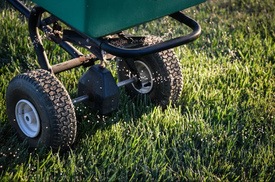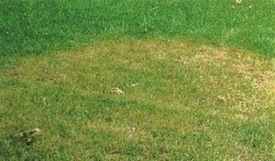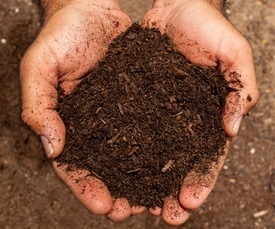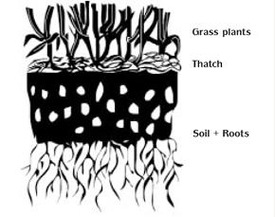
Spreading Fertilizer from BHG.com by Kelli Jo Emanuel
By CMG James P.
As the days get longer, the temperature rises, and there’s less football on TV, our thoughts turn to gardening, working in the yard, and green lawns. One of the top questions on people’s minds is always when to add nitrogen fertilizer to turf grass. The answer is, unless you are top dressing with compost, wait. This is not the answer most people expect or want to hear. Following are a few reasons why waiting is important, type of fertilizer, how much, and when to fertilize turf grass.
Lawns need nitrogen to look green and maintain health but adding nitrogen fertilizer too early in the spring is actually harmful. Aside from some of the more obvious reasons like wasting money by fertilizing the weeds instead of the grass and spring rains causing the nutrients to runoff into streams, rivers, and lakes, the turf grass can be damaged.
As turf grass emerges from dormancy, it uses energy stored in the roots. The energy in the roots needs to be replaced in order for the root system to be healthy and vigorous by the time the inevitable summer drought sets in. Adding nitrogen too early will divert growth to the leaves, instead of the roots. Also, nitrogen can damage the roots. The root cells are dividing rapidly at this time and they are sensitive to chemical burn, resulting in decreased vigor.

Brown Patch in Turf Grass from Bexar-tx.tamu.edu
Additionally, stimulating too much new leaf growth, too early, can also make the grass vulnerable to fungal attack, particularly Brown Patch (Rhizoctonia). Rhizoctonia is a naturally occurring fungal disease of turf grass. If the plant is healthy, the fungus usually doesn’t cause problems but if the conditions are right, the fungus can take hold. Once the grass is infected, chemical and environmental interventions are needed to get rid of the fungus. Turf is particularly vulnerable in the spring when the spores can sit on the grass blades for extended periods which are moist from nighttime rain, dew, or watering. The grass’s waxy cuticle helps to protect the blades. Tender, new growth doesn’t have a robust cuticle and the spores can penetrate the leaf tissue. If nitrogen fertilizer is added too early, it stimulates too much new growth when cool nights, warm days, and spring rains allow moisture to accumulate and sit on the leaves.

Compost from Thomas-Stone.com
The best fertilizer practices in Comal County are to top dress lawns with one quarter inch of high quality compost in early March each year. This adds organic matter to the soil, which improves water holding capacity and will slowly improve the pH of the soil. Top dressing is the absolute best fertilizer for lawns in our area but it works slowly, is a lot of work to put down and can be expensive. Most people choose to apply granular fertilizer.
For granular nitrogen fertilizer, apply twice a year, in mid-April and again in early September. The amount of fertilizer to apply depends on the nutrients available in the soil and type of turf. It is best to have the soil tested and apply the fertilizer according to the soil test. In the absence of a soil test, a good place to start for hybrid Bermuda is to apply 4.6 pounds of 21-0-0 Ammonium Sulfate per 1000 square feet of turf grass per application. St Augustine needs less Nitrogen and Zoysia even less. Most of the lawns in our area are Hybrid Bermuda.

Thach Management from Texas AgiLife Extension
Too much Nitrogen can cause a buildup of thatch. Also, applying too much nitrogen in the heat of the summer can burn the grass. Again, top dressing with high quality compost is the absolute best and should be applied in early March. When applying granular fertilizer, the timing and amount are very important. Apply 21-0-0 Ammonium Sulfate in mid-April and again in early September, at a rate of 4.6 pounds per thousand square feet for hybrid Bermuda. Read more on thatch management from Texas AgriLife Thatch Management for Home Lawns
For more information on turf grass fertilizer and more visit Texas A&M AgriLife Learn.